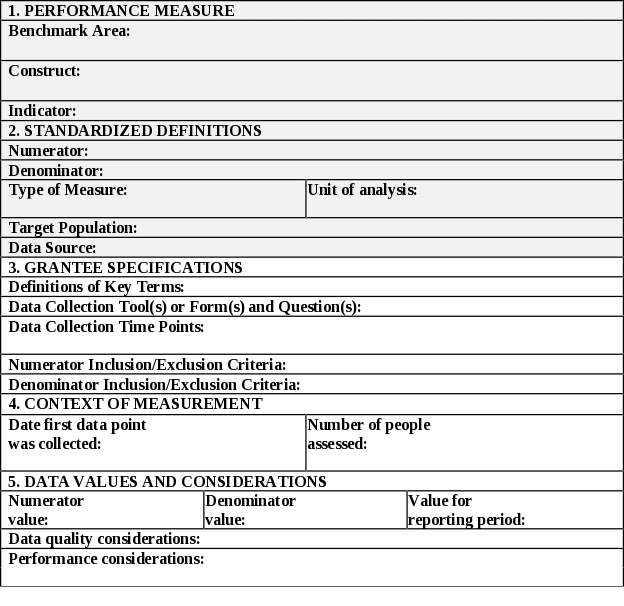Form PMR Tribal MIECHV Performance Measures Report
Tribal Maternal, Infant, and Early Childhood Home Visiting Program Data Reports: Demographic and Service Utilization, Grantee Performance Measures and Quarterly Performance Reports
THV PMR Form 2023_FINAL 04.10.2023
Tribal MIECHV Performance Measures Report
OMB: 0970-0614

Tribal Maternal, Infant, and
Early Childhood
Home Visiting Program
Data Reports:
Performance Measurement Data Report
+ OMB
Control No,: Expiration
Date: xx/xx/xxx
PAPERWORK REDUCTION ACT OF 1995 (Pub. L. 104-13) STATEMENT OF PUBLIC BURDEN: Through this information collection, ACF is gathering information to report activities associated with grants to the Maternal, Infant, and Early Childhood Home Visiting (MIECHV) program. The purpose of this information collection is to collect performance measurement data to HHS. Public reporting burden for this collection of information is estimated to average 288 hours per grantee, including the time for reviewing instructions, gathering and maintaining the data needed, and reviewing the collection of information. This is a collection of information through Section 511 of Title V of the Social Security Act. An agency may not conduct or sponsor, and a person is not required to respond to, a collection of information subject to the requirements of the Paperwork Reduction Act of 1995, unless it displays a currently valid OMB control number. The OMB # is XXXX and the expiration date is xx/xx/xxxx.
TRIBAL MATERNAL, INFANT, AND EARLY CHILDHOOD HOME VISITING
PERFORMANCE MEASUREMENT
DATA REPORT

Instructions for the Completion of Performance Measurement Data Report
Grantee Performance Measures
Sections 1 (Performance Measure) and 2 (Standardized Definitions) have been provided for all measures and are not modifiable, as these items have been standardized across all grantees.
Please complete Sections 3, 4, and 5 for each performance measure. Only enter information for the Flex Measures you’re reporting on (leave all other Flex Measures completely blank). The items below with asterisks (*) should be entered during the first year of reporting and will then be carried over in each subsequent year’s Performance Measurement Data Report (i.e., THVRS will automatically pre-populate these items with the data from the prior year). Please do not update these fields unless it is approved by your FPO.
Grantee Specifications
Definitions of key terms*: Clarify the meaning of the terms utilized in the measure definition (e.g., what counts as a “home visit?”). The terms that require clarification are listed in the grant recipient’s Performance Measurement Plan.
Data collection tool(s) or form(s) and question(s)*: Include any tools utilized to collect the data. If no measurement tool or scale is needed, state the question(s) posed to collect the needed information.
Data collection time points*: Specify the time(s) when the data will be collected (e.g., 3-months post enrollment, after each home visit). If the grant recipient has identified a window for data collection in the Performance Measurement Plan (e.g., +/- 1 month of the 3-month post enrollment time point), that should be included here. If multiple data elements are used to calculate the numerator and denominator, include the time points for all data elements.
Numerator inclusion/exclusion criteria*: Describe the criteria you will use to determine what data are included in the numerator and/or what data are not included (beyond the parameters set in the measure definition).
Denominator inclusion/exclusion criteria*: Describe the criteria you will use to determine what data are included in the denominator and/or what data are not included (beyond the parameters set in the measure definition).
Context of Measurement
Date first data point was collected*: Specify the first date (MM/DD/YYYY) that any performance measurement data were collected for each measure (e.g., if a measure specifies that data are first collected from primary caregivers at 3-months post enrollment, then the date provided would be the first date that any participating primary caregiver reached this target and was assessed). These data are only entered the first time data are reported and then should not be updated in future reports.
Number of people assessed: Indicate the number of individual participants who were assessed for the measure during the reporting period. If the unit of analysis (indicated in Section 1) is “Participant,” this number will be the same as the denominator.
Data Values and Considerations
Numerator value: Enter the value obtained for the numerator during the reporting period.
Denominator value: Enter the value obtained for the denominator during the reporting period.
Value for reporting period: The value for the reporting period will be auto calculated by the Tribal Home Visiting Reporting System. The value will be calculated as the numerator divided by the denominator.
Data quality considerations: Describe how the numerator and denominator were calculated (e.g., what was the total number of caregivers that could have been included in the denominator and how did you arrive at the denominator value reported). Explain any factors that affected your ability to report complete and accurate data (e.g., missing data because a home visitor left the team and data was not collected at the specified time point).
Performance considerations: Explain any factors that affected your ability to demonstrate improved performance for the measure (e.g., a major health clinic closed affecting the ability of program participants to receive well-child visits).
Tribal MIECHV Performance Measures Numerators and Denominators |
|||||
|
Area |
Construct |
Indicator |
Numerator |
Denominator |
Core Measures |
|||||
1 |
Implementation |
Receipt of Home Visits
|
Percentage of recommended home visits received by families enrolled in the home visiting program during the reporting period |
Number of home visits received by families during the reporting period |
Number of home visits families should receive according to model developer fidelity requirements during the reporting period |
2 |
Implementation |
Home Visit Implementation Observation
|
Percentage of recommended home visits where home visitors are observed for implementation quality and receive feedback from their supervisors during the reporting period |
Number of home visits where home visitors are observed for implementation quality and receive feedback from their supervisors during the reporting period |
Number of home visits where home visitors should receive an observation according to model developer guidelines during the reporting period |
3 |
Implementation |
Reflective Supervision |
Percentage of recommended individual reflective supervision sessions received by home visitors during the reporting period |
Number of individual reflective supervision sessions received by home visitors during the reporting period |
Number of individual reflective supervision sessions that home visitors should receive during the reporting period |
4 |
I - Maternal and Newborn Health |
Depression Screening |
Percentage of primary caregivers enrolled in HV who are screened for depression using a validated tool within six months of enrollment (for those not enrolled prenatally) or by three months post- delivery (for those enrolled prenatally) and at least annually thereafter |
For those not enrolled prenatally, number of primary caregivers enrolled in HV who are screened for depression within the first six months since enrollment; for those enrolled prenatally, the number of primary caregivers screened for depression by three months post- delivery; or annually after the first year of enrollment |
Number of primary caregivers not enrolled prenatally who are enrolled in HV for at least six months; the number of participants enrolled prenatally who have reached three months post-delivery |
5 |
I - Maternal and Newborn Health |
Substance Abuse Screening |
Percentage of primary caregivers enrolled in HV who are screened for substance abuse using a validated tool within six months of enrollment and at least annually thereafter |
Number of primary caregivers enrolled in HV who are screened for substance abuse using a validated tool within six months of enrollment and annually after the first year of enrollment |
Number of primary caregivers enrolled in HV for at least six months |
6 |
I - Maternal and Newborn Health |
Well Child Visit |
Percentage of the AAP-recommended number of well-child visits received by children enrolled in home visiting during the reporting period |
Number of AAP-recommended well-child visits received by children (index child) enrolled in home visiting during the reporting period |
Number of AAP-recommended well-child visits children (index child) enrolled in home visiting should receive during the reporting period |
7 |
II - Child Maltreatment, Injuries and ED Visits |
Child Injury Prevention |
Percentage of primary caregivers enrolled in home visiting who are provided with an annual training on prevention of infant and child injuries |
Number of primary caregivers enrolled in home visiting who are provided with training on prevention of infant and child injuries during the reporting period |
Number of primary caregivers enrolled in home visiting |
8 |
III – School Readiness and Achievement |
Parent-Child Interaction |
Percentage of primary caregivers enrolled in HV who receive an annual observation of caregiver-child interaction by the home visitor using a validated tool. |
Number of primary caregivers enrolled in HV who receive an observation of caregiver-child interaction by the home visitor using a validated tool during the reporting period |
Number of primary caregivers enrolled in HV with children in the age range specified by the tool |
9 |
III – School Readiness and Achievement |
Developmental Screening |
Percentage of children enrolled in HV screened at least annually for developmental delays using a validated parent-completed tool |
Number of children (index child) enrolled in HV with at least one documented developmental screening during the reporting period. |
Number of children (index child) enrolled in HV during the reporting period that required a screening |
10 |
IV - Crime or Domestic Violence |
IPV Screening |
Percentage of primary caregivers enrolled in HV who are screened for intimate partner violence using a validated tool within six months of enrollment and at least annually thereafter |
Number of primary caregivers enrolled in HV who are screened for IPV using a validated tool within six months of enrollment and annually after the first year of enrollment |
Number of primary caregivers enrolled in HV for at least six months |
11 |
V - Family Economic Self-Sufficiency |
Screening for Economic Strain |
Percentage of primary caregivers who are screened for unmet basic needs (poverty, food insecurity, housing insecurity, etc.) within six months of enrollment and at least annually thereafter |
Number of primary caregivers who are screened for unmet basic needs within six months of enrollment and annually after the first year of enrollment |
Number of primary caregivers enrolled in home visiting for at least six months |
12 |
VI- Coordination and Referrals |
Completed Developmental Referrals |
Percentage of children enrolled in home visiting with positive screens for developmental delays (measured using a validated tool) who receive a referral for services and individualized developmental support from their home visitor |
Number of children (index child) enrolled in HV who were referred to other community services and received individualized developmental support from a home visitor during the reporting period |
Number of children (index child) enrolled in HV during the reporting period with positive screens for developmental delays (measured using a validated tool) |
Flex Measures (select 2 from 1-7 and 1 from 8-11) |
|||||
1 |
I - Maternal and Newborn Health |
Breastfeeding |
Percentage of participants enrolled prior to child’s birth who initiate breastfeeding |
Number of participants enrolled prenatally who initiate breastfeeding |
Number of participants enrolled prenatally who gave birth within the reporting period |
2 |
I - Maternal and Newborn Health |
Postpartum Care |
Percentage of participants enrolled in HV prenatally or within 30 days after delivery who received a postpartum visit with a health care provider within eight weeks (56 days) of delivery. |
Number of participants enrolled in HV prenatally or within 30 days after delivery who received a postpartum visit with a health care provider within eight weeks (56 days) of delivery |
Number of participants who enrolled in HV prenatally or within 30 days after delivery and remained enrolled for at least eight weeks (56 days) after delivery |
3 |
I - Maternal and Newborn Health |
Immunizations |
Percentage of children enrolled in home visiting who receive all AAP-recommended immunizations during the reporting period |
Number of children (index child) enrolled in HV who receive all AAP-recommended immunizations during the reporting period |
Number of children (index child) enrolled in HV during the reporting period |
4 |
II - Child Maltreatment, Injuries and ED Visits |
Screening for Parenting Stress |
Percentage of primary caregivers who are screened for parenting stress using a validated tool within six months of enrollment (for those not enrolled prenatally) or by three months post- delivery (for those enrolled prenatally), and at least annually thereafter |
For those not enrolled prenatally, number of primary caregivers enrolled in HV who are screened for parenting stress within the first six months since enrollment; for those enrolled prenatally, the number of primary caregivers screened for parenting stress by three months post- delivery; or annually after the first year of enrollment |
Number of primary caregivers not enrolled prenatally who are enrolled in HV for at least six months; the number of participants enrolled prenatally who have reached three months post-delivery |
5 |
II - Child Maltreatment, Injuries and ED Visits |
Safe Sleep |
Percentage of primary caregivers educated about the importance of putting infants to sleep on their backs, without bed-sharing and soft-bedding |
Number of primary caregivers educated about the importance of putting infants to sleep on their backs, and without bed-sharing and soft-bedding during the reporting period |
Number of primary caregivers enrolled in home visiting during the reporting period who are either pregnant or have a child under 12 months of age and have not already received safe sleep education in the previous reporting period |
6 |
II - Child Maltreatment, Injuries and ED Visits |
Child Injury |
Rate of injury-related visits to the Emergency Department (ED) or urgent care since enrollment among children enrolled in HV |
Number of parent-reported nonfatal injury-related visits to the Emergency Department (ED) or urgent care since enrollment among children (index child) enrolled in HV |
Number of children (index child) enrolled in HV during the reporting period |
7 |
III – School Readiness and Achievement |
Early Language and Literacy Activities |
Percentage of children enrolled in HV with a caregiver who reported that during a typical week the caregiver or a family member read, told stories, and/or sang songs with their child every day |
Number of children (index child) enrolled in HV with a caregiver who reported that during a typical week the caregiver or a family member read, told stories, and/or sang songs with their child every day. |
Number of children (index child) enrolled in HV during the reporting period |
8 |
VI- Coordination and Referrals |
Completed IPV referrals |
Percentage of primary caregivers screening positive for intimate partner violence using a validated tool who receive a referral for services |
Number of primary caregivers enrolled in HV who received referral information to appropriate services (and met the conditions specified in the denominator) |
Number of primary caregivers enrolled in HV with positive screens for IPV (measured using a validated tool) |
9 |
VI- Coordination and Referrals |
Completed Depression or Parenting Stress Referrals |
Percentage of primary caregivers screening positive for depression or parenting stress using a validated tool who receive a referral for services |
Number of primary caregivers enrolled in HV who received referral information to appropriate services (and met the conditions specified in the denominator) |
Number of primary caregivers enrolled in HV who had a positive screen for depression or parenting stress (measured using a validated tool) |
10 |
VI- Coordination and Referrals |
Completed Substance Abuse Referrals |
Percentage of primary caregivers screening positive for substance abuse using a validated tool who receive a referral for services |
Number of primary caregivers enrolled in HV who received referral information to appropriate services (and met the conditions specified in the denominator) |
Number of primary caregivers enrolled in HV who had a positive screen for substance abuse (measured using a validated tool) |
11 |
VI- Coordination and Referrals |
Completed Economic Strain Referrals |
Percentage of primary caregivers with unmet basic needs who receive a referral for services |
Number of primary caregivers enrolled in HV who received referral information to appropriate services (and met the conditions specified in the denominator) |
Number of primary caregivers enrolled in HV who had a positive screen for unmet basic needs |
| File Type | application/vnd.openxmlformats-officedocument.wordprocessingml.document |
| Author | Department of Health and Human Services |
| File Modified | 0000-00-00 |
| File Created | 2023-07-29 |
© 2025 OMB.report | Privacy Policy